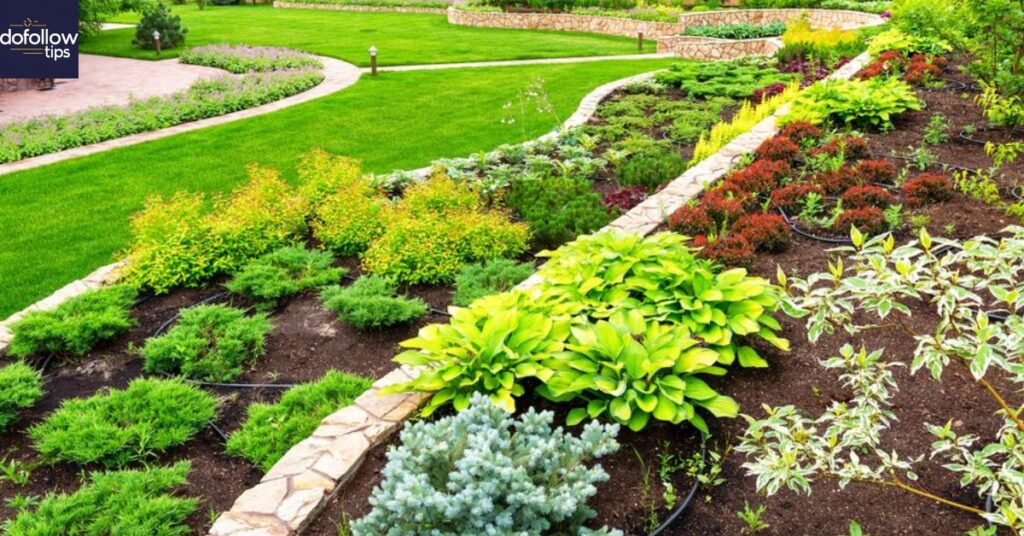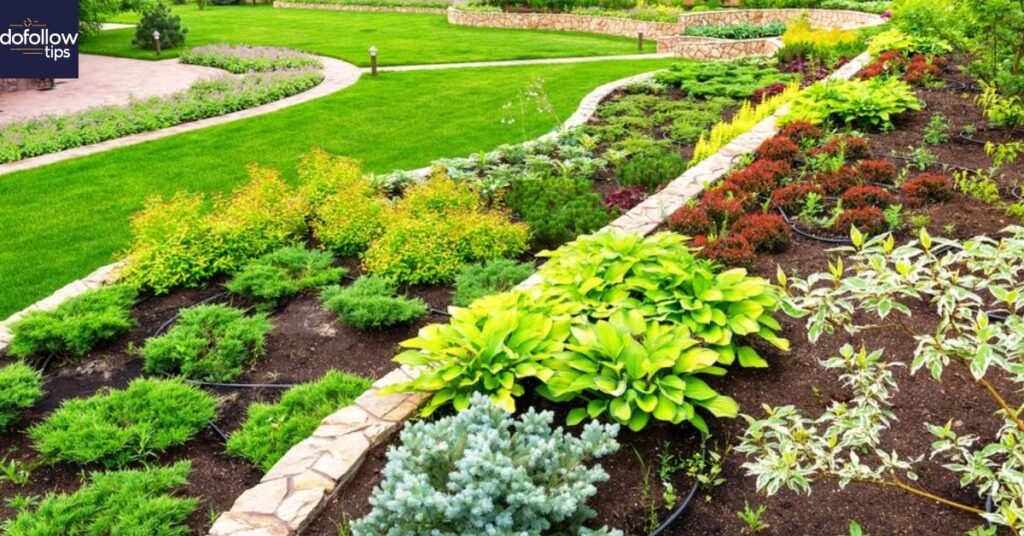Transforming your outdoor space into a stunning oasis is easier than you think. This ultimate guide to home landscaping offers a wealth of ideas, practical tips, and inspiration for every yard size and style.
From boosting curb appeal with eye-catching front yard designs to creating functional backyard retreats, we cover it all. Learn about sustainable practices, low-maintenance solutions, and budget-friendly options that can breathe new life into your property.
Understanding the Basics of Home Landscaping

What is Home Landscaping?
Home landscaping is the process of enhancing your outdoor living spaces. It involves planning, designing, and maintaining your yard.
Landscaping includes both soft elements like plants and hard elements like patios. It’s about creating a harmonious blend of nature and structure. Good landscaping reflects your personal style and meets your practical needs.
READ THIS BLOG: Unlocking the Phrase: When Doubled, A Mild Reprimand
Benefits of Landscaping Your Home
Landscaping offers numerous benefits to homeowners. It significantly boosts curb appeal, making your home more attractive. Well-designed landscapes can increase property values by up to 20%.
They create outdoor living spaces for relaxation and entertainment. Landscaping also has environmental benefits. It can improve air quality and reduce noise pollution. Proper landscaping can even lower your energy bills by providing natural insulation.
Planning Your Home Landscaping Project
Assessing Your Yard’s Needs and Potential
Start by evaluating your current landscape. Consider the soil type, sunlight exposure, and drainage patterns. Identify problem areas that need attention.
Think about how you want to use your outdoor space. Do you need a play area for kids? Or a quiet spot for reading? Make a list of your priorities. This will guide your landscaping decisions.
Creating a Landscaping Budget
Set a realistic budget for your project. Landscaping costs can vary widely. Factor in expenses for plants, materials, and labor. Don’t forget to include ongoing maintenance costs.
Consider tackling the project in phases if needed. This can help spread out the expenses over time. Remember, good landscaping is an investment in your property.
Designing Your Landscape
Create a landscape design that suits your style and needs. Consider the architecture of your home. Your landscape should complement it. Balance is key in design.
Mix hardscaping elements with greenery. Use focal points to draw the eye. Think about how your landscape will look in different seasons. Plan for growth and changes over time.
Front Yard Landscaping Ideas
Curb Appeal Boosters
Your front yard is the first thing people see. Make it welcoming and attractive. Add color with flower beds or planters. Create a clear, inviting path to your front door. Use lighting to highlight key features at night. Keep your lawn well-maintained. Consider adding a small seating area for a homey touch.
Creative Landscaping Features
Unique features can make your front yard stand out. Install a water feature like a small fountain. Create visual interest with ornamental grasses or sculptural plants. Use decorative rocks or boulders as accent pieces. Add a stylish mailbox or house numbers. Consider a tree with attractive bark or leaves for a focal point.
Backyard Landscaping Ideas

Creating Functional Outdoor Spaces
Design your backyard for how you’ll use it. Create distinct zones for different activities. Add a patio or deck for outdoor dining. Install a fire pit for cozy gatherings. If you have kids, include a play area. For relaxation, consider a hammock or comfortable seating area. Don’t forget storage for outdoor equipment.
Incorporating Gardens and Plant Beds
Gardens add beauty and can be functional too. Plant a vegetable garden for fresh produce. Create flower beds with a mix of perennials and annuals. Use raised beds for easier maintenance. Add herbs for cooking and fragrance. Consider a butterfly garden to attract pollinators. Use container gardens for flexibility.
Enhancing Backyard Aesthetics
Make your backyard visually appealing. Use vertical gardening on walls or fences. Add a pergola for shade and visual interest. Install landscape lighting for ambiance at night. Create privacy with strategic plantings or screens. Use garden art or sculptures as focal points. Consider adding a water feature like a pond or fountain.
Sustainable and Eco-Friendly Landscaping
Benefits of Sustainable Landscaping
Sustainable landscaping is good for the environment and your wallet. It reduces water usage and maintenance needs. It supports local ecosystems and wildlife. Sustainable landscapes are more resilient to pests and diseases. They can improve air and soil quality. These landscapes often require less fertilizer and fewer pesticides.
Sustainable Landscaping Practices
Choose native plants adapted to your local climate. Group plants with similar water needs together. Use mulch to retain soil moisture and suppress weeds. Compost yard waste to create natural fertilizer. Reduce lawn size to minimize water use and mowing. Plant trees strategically for natural cooling and energy savings.
Water Conservation Techniques
Implement water-saving strategies in your landscape. Install a drip irrigation system for efficient watering. Use rain barrels to collect and reuse rainwater. Choose drought-tolerant plants that need less water. Create a rain garden to manage storm water runoff. Use permeable paving materials to allow water to soak into the ground.
Low-Maintenance Landscaping Solutions
Choosing Low-Maintenance Plants
Select plants that require minimal care. Native species are often low-maintenance choices. Use groundcovers instead of grass in hard-to-mow areas. Choose perennials that come back year after year. Plant shrubs and trees that don’t need frequent pruning. Use succulents in dry areas for easy care.
Simplifying Garden Care
Design your garden for easy maintenance. Use mulch to reduce weeding and watering needs. Install automatic irrigation systems. Group plants with similar care requirements together. Use raised beds to minimize bending and stooping. Choose disease-resistant plant varieties. Implement companion planting to naturally deter pests.
Hardscaping for Minimal Upkeep
Incorporate hardscaping elements for less maintenance. Install pavers or decking instead of high-maintenance lawns. Use gravel or rock gardens in difficult-to-plant areas. Add retaining walls to control erosion on slopes. Choose durable materials that don’t need frequent replacement. Use artificial turf for a low-maintenance lawn alternative.
Common Landscaping Challenges and Solutions
Dealing with Difficult Terrain
Slopes and uneven ground can be challenging. Use terracing to create level planting areas. Install retaining walls to prevent erosion. Plant ground covers on steep slopes. Use steps or switchback paths for accessibility. Choose plants with strong root systems for slope stabilization.
Solving Drainage Issues
Poor drainage can damage your landscape. Install French drains to redirect water. Create swales to channel water away from structures. Use rain gardens to absorb excess water. Improve soil structure to enhance drainage. Grade your yard properly to prevent water pooling.
Pest and Wildlife Management
Manage pests and wildlife without harming the environment. Use companion planting to deter pests naturally. Install physical barriers like fences or netting. Choose plants that are resistant to common pests. Encourage beneficial insects that prey on pests. Use organic pest control methods when necessary.
DIY Landscaping Projects for Homeowners
Easy Projects for Beginners
Start with simple projects to build your skills. Create a container garden with flowers or herbs. Install landscape edging around beds. Build a simple bird bath or feeder. Plant a small tree or shrub. Create a stepping stone path.
Intermediate Projects for Enthusiasts
Take on more challenging projects as you gain experience. Build a raised garden bed for vegetables. Install a basic irrigation system. Create a small water feature. Build a simple pergola or arbor. Design and plant a themed garden.
Advanced Projects for Experienced DIYers
Tackle complex projects with confidence. Build a custom deck or patio. Install a pond with a waterfall. Construct a outdoor kitchen area. Design and implement a comprehensive landscape lighting system. Build a greenhouse for year-round gardening.
Hiring a Professional Landscaper
When to Hire a Professional
Consider professional help for complex projects. Hire experts for major grading or drainage issues. Seek professional design services for comprehensive landscape plans. Use professionals for large-scale hardscaping projects. Consider experts for specialized gardens or water features.
ALSO READ THIS : Feast Your Eyes on the Best Turkey Clipart: A Visual Guide
Choosing the Right Landscaper
Select a landscaper carefully. Check for proper licensing and insurance. Ask for references and portfolio of past work. Get detailed written estimates. Ensure clear communication about your vision and budget. Choose a landscaper with experience in your specific needs.
Frequently Asked Questions
What are the best low-maintenance plants for my yard?
Native plants, succulents, and perennials are excellent low-maintenance options. They require less water and care once established.
How can I improve my soil quality for better plant growth?
Add organic matter like compost to improve soil structure and fertility. Test your soil and amend as needed with appropriate nutrients.
What’s the best way to create privacy in my backyard?
Use a combination of fencing, tall shrubs, and trees. Consider fast-growing plants like bamboo or evergreens for quick privacy.
How do I create a landscape that looks good year-round?
Include a mix of evergreens, deciduous plants, and plants with winter interest. Plan for seasonal color with bulbs and perennials.
What are some eco-friendly alternatives to traditional lawns?
Consider native meadows, groundcovers, or xeriscaping. These options require less water and maintenance than traditional lawns.
Conclusion
Landscaping your home is a rewarding journey that transforms your outdoor spaces. With the ideas, tips, and inspiration from this guide, you’re well-equipped to create a beautiful and functional yard. Remember, the key is to start with a solid plan and work at your own pace.
Whether you choose to DIY or hire professionals, focus on creating a landscape that reflects your style and meets your needs. Don’t be afraid to experiment with different plants, features, and designs until you find what works best for your space. Your perfect outdoor oasis is within reach.

Anthony is a seasoned SEO expert with a passion for content writing, keyword research, and web development. He combines technical expertise with creative strategies to deliver exceptional digital solutions.












